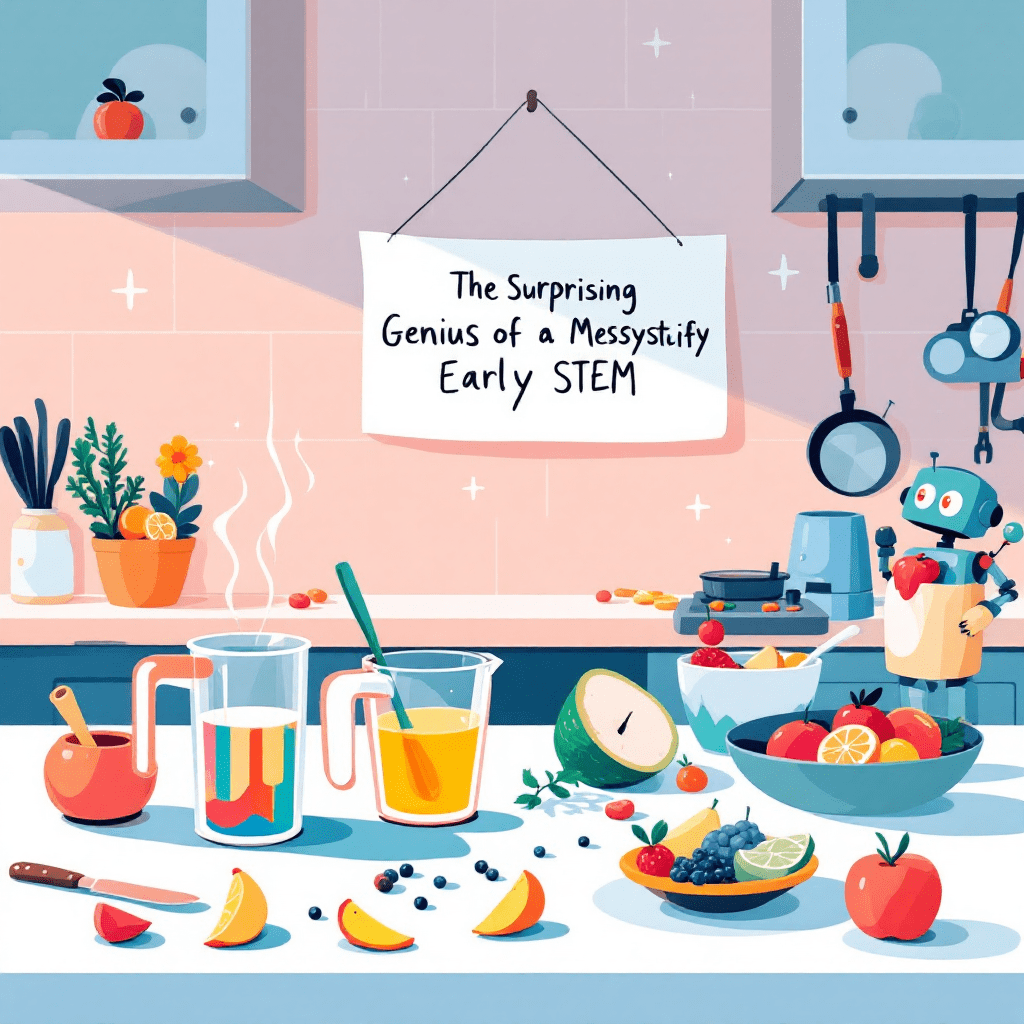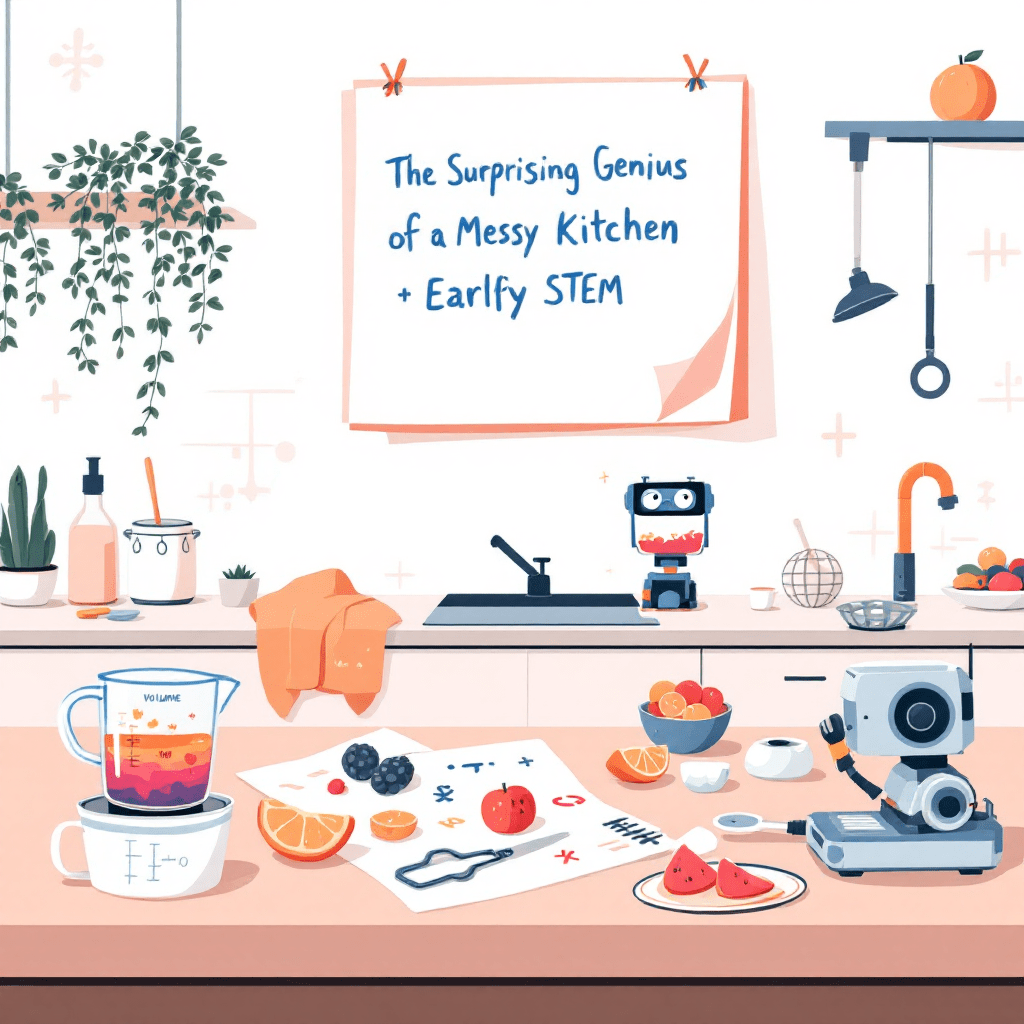- Ark's Newsletter
- Posts
- The Surprising Genius of a Messy Kitchen: 5 Truths That Demystify Early STEM
The Surprising Genius of a Messy Kitchen: 5 Truths That Demystify Early STEM
Introduction: Beyond the Beakers and Buzzwords
In the world of modern parenting, the term “STEM” (Science, Technology, Engineering, and Math) can feel like both a promise and a pressure. It often conjures images of expensive robotics kits, complex coding classes, and specialized resources that feel intimidating and out of reach. We’re told our children need these skills to succeed, but the path to fostering them seems complicated and costly.
The truth, however, is far more surprising and accessible. The most powerful and effective STEM learning doesn’t come from a fancy lab or a prepackaged kit. It’s already happening in your living room, your kitchen, and your backyard. It’s happening when your child marvels at how colors mix to become new ones, wonders how a tower of cups can stand so tall, or asks why bubbles pop. It’s embedded in everyday play, using the most common household items.
This article will reveal five simple truths that will transform how you see early childhood learning. Forget the buzzwords and the expensive toys. Let’s uncover the profound science hidden in the simple act of play.

1. Play Isn’t Just Fun—It’s Foundational Brain-Building
When your toddler is splashing water or squishing dough, it’s easy to dismiss it as idle fun. But what looks like a delightful mess is actually intensive brain construction. Science tells us that during these early years, a child’s brain is forming more than one million new neural connections every second through this exact kind of sensory exploration.
This isn’t an exaggeration; it’s the biological engine of early learning. According to research from Michigan State University Extension, this sensory play is “the foundation of all the skills children will use in school learning to read, write, and solve math and science problems.” The neural architecture they build while methodically exploring textures, sounds, and physical properties is the very same architecture they will later use to grasp abstract academic concepts.
This reframes the parent’s role entirely. You don’t need to be a formal “teacher” with a lesson plan. Instead, you become a “facilitator of curiosity,” providing the safe space and simple materials for your child’s brain to do what it does best: build itself through joyful, natural discovery.
2. Your Kitchen Is Already a Fully-Equipped Science Lab
You don’t need to invest in a dedicated science lab to spark a love for discovery. Your kitchen is already equipped with everything you need. Simple ingredients that you have in your cabinets right now—like vinegar, baking soda, oil, and food coloring—are the only supplies required for dozens of amazing, hands-on experiments.
Consider these simple yet profound examples:
DIY Lava Lamp: By combining vegetable oil, water, and a sodium bicarbonate tablet in a clear vase, your child can witness scientific principles in action. This simple setup beautifully demonstrates how liquid density works (oil and water don’t mix) and how a chemical reaction can produce carbon dioxide gas, creating the mesmerizing “lava” effect.
The Naked Egg: What happens when you submerge a raw egg in a glass of vinegar for two days? The acid in the vinegar completely dissolves the calcium carbonate shell, leaving only the soft, squishy inner membrane intact. Your child is left with a “naked” egg they can gently bounce, providing an unforgettable lesson in chemical reactions.
This is a game-changer for parents because it makes science immediate, inexpensive, and a natural extension of daily life. The barrier to entry is zero, but the potential for learning is limitless.

3. Simple Household Items Teach Profound Scientific Principles
You might be surprised to learn that you can demonstrate advanced scientific principles like polymer science, air pressure, and capillary action using items you can grab from a drawer. The most powerful learning tools are often the most mundane.
The Leakproof Water Bag teaches polymer science with just a zip-lock bag, water, and a few sharp pencils. When you fill the bag with water and stab the pencils straight through it, the bag miraculously doesn’t leak. This is because the plastic bag is made of polymers—long, flexible chains of molecules that spread apart and create a tight seal around the pencil.
Balloon rockets demonstrate physics with a balloon, a straw, a string, and tape. By taping an inflated (but untied) balloon to a straw threaded on a string, you can create a rocket that zooms across the room when you let it go. This provides a fun, practical lesson on how air pressure works to create motion.
These activities do more than just entertain; they teach children to observe the world with a scientific mindset. They learn to look for the “how” and “why” behind everyday phenomena, transforming them from passive observers into active investigators. This is the very heart of scientific thinking: forming a hypothesis (What will happen if…?), testing it, and observing the results—even if they don’t yet have the words for it.
4. STEM Doesn’t Just Build Structures—It Builds Resilience
While early STEM activities are excellent for developing academic skills, their most significant impact may be on a child’s character. STEM challenges—like building the tallest tower or figuring out how to protect an egg from a fall—are safe, low-stakes environments for children to try, fail, and iterate without fear.
Research from a STEM summer camp for preschoolers revealed just how deeply this lesson can take root. As the young participants worked together to solve problems, they weren’t just learning about engineering; they were learning how to be engineers. One four-year-old, reflecting on a challenge, perfectly captured the spirit of this discovery:
“We need to keep trying because engineers never give up!”
This resilient mindset—the willingness to persist through failure, to collaborate, and to try a new approach—is perhaps the most valuable and lasting lesson from early STEM exploration. It’s a skill that will serve them far beyond the classroom, in every aspect of their lives.

5. Early STEM Play Challenges Gender Stereotypes from Day One
Cultural stereotypes about certain subjects being for “boys” or “girls” often take root unconsciously in early childhood. The belief that boys are better at math or that engineering is a male profession can be absorbed long before children enter formal schooling. Early, play-based STEM provides a powerful and immediate antidote.
pretestThe findings from the STEM Summer Camp were staggering. Before the camp began, a pre-test showed that 50% of the preschoolers believed that engineering was a profession only for boys. After just two weeks of engaging in fun, play-based activities like building structures and designing circuits, their perspectives were completely transformed. In the post-test, 100% of the children—both boys and girls—answered that engineering was a profession for both boys AND girls.
This demonstrates the profound social impact of early STEM exposure. By presenting activities like building, experimenting, and problem-solving as fun for everyone, parents and educators can actively dismantle harmful stereotypes from day one. They foster a more inclusive and equitable mindset, ensuring every child feels empowered to pursue their curiosity, wherever it may lead.
Conclusion: Your Next Great Discovery Awaits
Powerful STEM learning is not about mastering complex subjects or using expensive equipment. It is about nurturing a child’s natural curiosity and seeing the extraordinary science hidden within ordinary play. It’s about empowering them with the confidence to ask questions, the resilience to handle failure, and the creativity to find their own answers.
The tools for this profound education are already in your home, waiting to be discovered. The next time your child gets messy building a ramp out of cardboard or gets excited watching colors mix in a cup, what scientific discovery might they be on the verge of making?